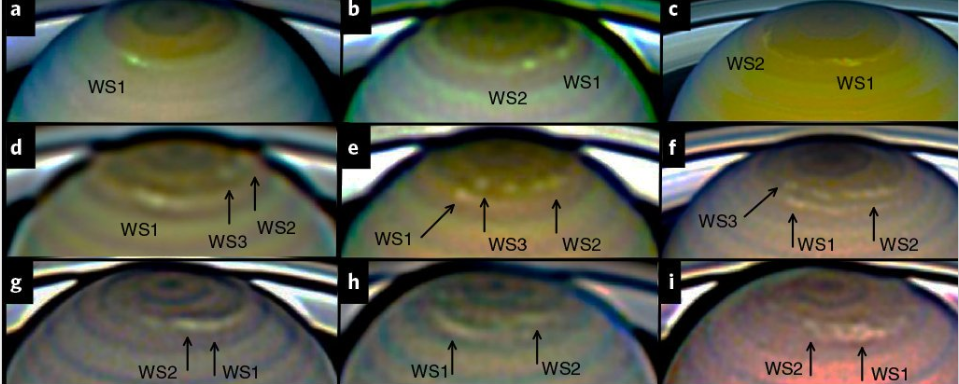New type of storm discovered on Saturn’s surface

A new type of storm was discovered on Saturn's surface. The researchers analyzed hundreds of snapshots taken by amateur astronomers and developed simulations to understand the strange weather events. Telescope imagery revealed long patches of bright clouds near Saturn's north pole on four different events between March and October.
The white patches, stretching a distance between around 4 000 to 8 000 km (2 485 to 4 970 miles), measure twice as much as the size of the usual cyclonic activity that occurs from time to time in Saturn's bands.
The patches took time to fade, overlapping another as new cyclones occur. One lasted for 214 days.

Image credit: Sanchez-Lavega et al/Nature Astronomy
However, as big as they were, none came close to matching the seasonal phenomenon, Great White Spots, which were only observed on seven occasions since 1876. These storms apparently happen every 28.5 years, coinciding with the planet's northern summer. In 2010, a spot close to the equator outdid previous storms despite being premature, appearing a full decade ahead of expectations.
Scientists hypothesized that the massive storms are caused by cycles of cooling that contract lighter gases in the upper atmosphere, sending them below heavy and wet layers of cloud further down, forcing them to lift their warmth.
"Made mostly of hydrogen and helium, Saturn's overall density is less than water, meaning it would bob around in a bathtub big enough to hold it. But there are other gases in the mix as well, including trace amounts of water and ammonia, and hydrocarbons like methane and propane. Layers of these gases whip about in currents that can reach speeds of 1 800 km/h (over 1 100 mph) near the equator; more than four times as fast as our own planet's fastest winds."
A big portion of the planet's activity is driven by energetic processes of rising and falling fluids and its quick rotation.
The four cyclones, although were not as impressive as the Great White spots, came at just the right time to make astronomers think if the phenomena is simply undernourished cyclone events.
The storms also appeared at latitudes the same to the one that hosted a spot in the 1960s.
According to the researchers' simulations, the kind of energy needed to spark these four medium-sized occurrences would be 10 times more than necessary for smaller storms, but 100 times less than what would be required for a Great White Spot to happen.
Their long-lasting attribute suggests that something is feeding their fury beneath the clouds. "They could be unique events in their own right. Time will tell. With so many eyes on the planet – both amateur and professional – we're sure to learn more about Saturn's strange behavior in the coming years."
Reference
"A complex storm system in Saturn’s north polar atmosphere in 2018" – Sanchez-Lavega, A. et al – Nature Astronomy – DOI: 10.1038/s41550-019-0914-9
Abstract
Saturn’s convective storms usually fall in two categories. One consists of mid-sized storms ∼2,000 km wide, appearing as irregular bright cloud systems that evolve rapidly, on scales of a few days. The other includes the Great White Spots, planetary-scale giant storms ten times larger than the mid-sized ones, which disturb a full latitude band, enduring several months, and have been observed only seven times since 1876. Here we report a new intermediate type, observed in 2018 in the north polar region. Four large storms with east–west lengths ∼4,000–8,000 km (the first one lasting longer than 200 days) formed sequentially in close latitudes, experiencing mutual encounters and leading to zonal disturbances affecting a full latitude band ∼8,000 km wide, during at least eight months. Dynamical simulations indicate that each storm required energies around ten times larger than mid-sized storms but ∼100 times smaller than those necessary for a Great White Spot. This event occurred at about the same latitude and season as the Great White Spot in 1960, in close correspondence with the cycle of approximately 60 years hypothesized for equatorial Great White Spots.
Featured image credit: @wikiimages/Pixabay

Commenting rules and guidelines
We value the thoughts and opinions of our readers and welcome healthy discussions on our website. In order to maintain a respectful and positive community, we ask that all commenters follow these rules.